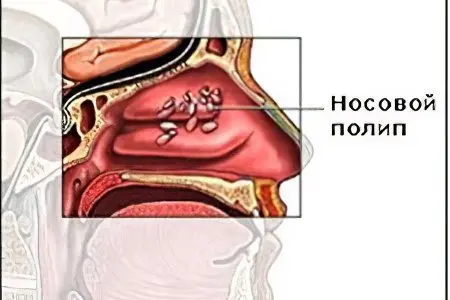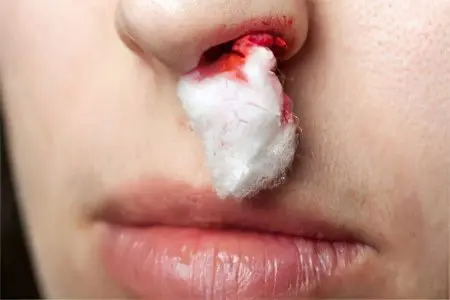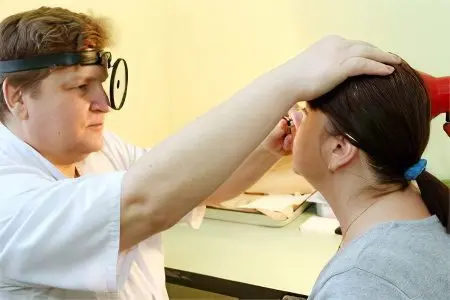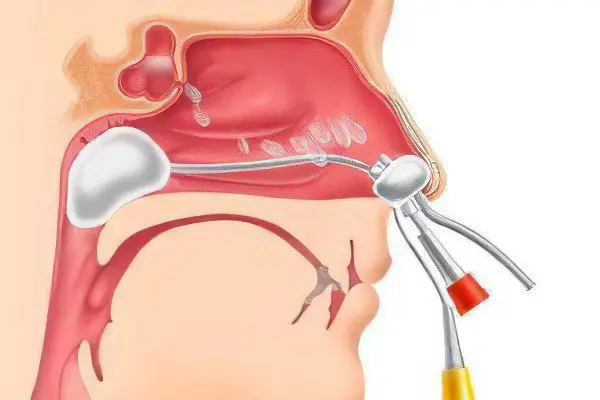Contents

Nasal polyps are benign round neoplasms that are the result of an overgrowth of the mucous membrane lining the nasal cavity. In appearance, they may look like mushrooms, peas or grapes.
According to statistics, nasal polyps are the most common complication of chronic rhinitis. In the world, according to various sources, from 1 to 4% of people suffer from them, most of the male carriers. They develop growths 4 times more often than women. If we turn to the structure of the outgrowths, then antrochoanal polyps predominate in children (formed from the mucous membrane lining the maxillary sinuses), and in the adult population, ethmoid polyps (formed from the mucous membrane lining the ethmoid labyrinth).
The main danger of nasal polyps is that, if left untreated, they can shorten the patient’s life by about 6 years. The fact is that any vasoconstrictor drops will not be able to facilitate nasal breathing with polyps. For this reason, a person has to breathe through his mouth all the time, which greatly aggravates the risk of various respiratory diseases, and also increases the likelihood of developing asthma.
Symptoms of polyps in the nose
Symptoms indicating the presence of polyps on the nasal mucosa are as follows:
Breathing through the nose is either difficult or impossible. A person experiences a feeling of constant congestion. Such difficulties are due to the fact that the tissues of the mucous membrane have grown and blocked (either completely or partially) the respiratory lumen of the nasal passage;
When a secondary infection joins, the mucous glands begin to work hard. For this reason, the patient has increased mucus production, in advanced cases it may have purulent impurities;
The person starts sneezing more often. This protective reaction of the body is explained by the fact that the polyp irritates the cilia that cover the walls of the nasal mucosa. They take it for a foreign body and with the help of a sneeze they try to clear their nose;
Headache. They are due to a number of factors. First, the body, including the brain, begins to suffer from a lack of oxygen. Secondly, significantly overgrown formations put pressure on the nerve endings, causing a natural pain reaction. Thirdly, a headache may be due to an inflammatory process occurring in the paranasal sinuses (in the sphenoid, maxillary, ethmoid labyrinth or in the frontal sinus);
Olfactory dysfunction. With significantly overgrown polyps, a complete loss of sensitivity to odors can be observed. This symptom is due to the fact that the overgrown connective tissue disrupts the functioning of the receptors that are responsible for the perception of aromas;
Large nasal polyps can affect the taste sensations of the patient and even cause an unpleasant aftertaste in the mouth;
In childhood, education can cause the formation of malocclusion. If a polyp appears in the first year of life, then this makes it difficult to feed it, since the child cannot normally suck and swallow food. As a result, the baby suffers from chronic malnutrition, which leads to weight loss and general malnutrition;
Change of voice, development of nasality. As a result of the fact that the flow of air through the nasal passages is disturbed, the patient begins to speak through the nose. In addition, it is known that the nose is the organ that is directly involved in the formation of speech sounds.
Stage of the disease
The severity of symptoms depends on what stage the growth is in:
At the first stage the outgrowth is small, therefore it covers only the upper nasal septum. The patient experiences a slight nasal congestion, which is often perceived as a normal ARVI. However, already at the initial stages, a polyp can provoke the development of otitis media, tonsillitis or adenoiditis;
The second stage nasal polyposis is characterized by further proliferation of connective tissue. The patient begins to experience difficulties with smell, his voice changes, nasality is acquired. When the formation reaches the auditory tube, speech begins to be distorted, hearing deteriorates. If you do not seek help at this stage, pathological changes may remain forever;
The third stage characterized by complete obstruction of the nasal passage, the symptoms are gaining full strength. When the infection joins, the body temperature rises. In addition, patients suffer from headaches, from increased fatigue. The quality of life is significantly reduced by constant discharge from the nose.
Causes of polyps in the nose

Before turning to the enumeration of the causes leading to the appearance of polyps, one should understand the mechanism of their occurrence. When a virus or bacterium enters the human body, infectious agents multiply. This provokes the exfoliation of cells of the nasal mucosa. A person begins to suffer from congestion, difficulty breathing, copious nasal discharge. If the immune system functions normally, and the person receives adequate treatment, then in about a week there is a complete recovery.
When the process becomes chronic, local immunity malfunctions, and the mucous membrane, in order to increase resistance to the disease, seeks to increase the occupied areas. The only way to realize this is to start growing and compacting. Most often, this process occurs in the paranasal sinuses. At some point, there is little room for dividing cells, and they go into the nasal cavity, and a polyp is formed.
Therefore, the specific reasons leading to the growth of the nasal mucosa are:
Infections and colds that are accompanied by a runny nose and occur quite often;
Chronic inflammation occurring in the paranasal sinuses – frontal sinusitis, ethmoiditis, sinusitis;
Runny nose of allergic origin (hay fever);
Diseases such as bronchial asthma, cystic fibrosis, Young’s syndrome, Churg-Strauss syndrome, nasal mastocytosis, Kartagener’s syndrome, aspirin intolerance;
Hereditary predisposition to polyposis;
Too narrow nasal passages, violations in the structure of the nasal septum;
Pathological failures in the immune defense.
That is, nasal polyps are a polyetiological disease, which is simultaneously affected by the anatomy of the nose, chronic inflammation of its sinuses and allergies.
Why are nasal polyps dangerous?
The danger of the growth of the nasal mucosa in the first place lies in the development of complications. When natural breathing through the nose is not hindered in any way, moistening and warming of the air entering the lungs occurs. In addition, dust particles are removed from it, which remain on the mucous membrane, and then are naturally excreted. Polyps do not allow air to pass freely through the nasal passage, which forces a person to breathe through the mouth.
As a result, the air does not have time to warm up properly, which provokes diseases such as:
Pneumonia;
Bronchitis;
Laryngitis;
Tracheitis;
Pharyngitis;
Laryngotracheitis.
As a result of the fact that there is a violation of the natural communication between the sinuses, the patient suffers from chronic sinusitis.
The larger the growth, the more it presses on the blood vessels of the nasopharyngeal tissue, thereby causing inflammation of the tonsils and the formation of adenoids, an increase in the palatine tonsils with symptoms of angina. Also, circulatory disorders can lead to the development of a clinic of chronic tonsillitis. As for violations of the auditory tube, the increased pressure on it leads to the development of otitis media or eustachitis.
Diagnosis of a polyp in the nose

To suspect that the patient has a polyp in the nose, the doctor can by a nasal voice, even if the patient himself does not complain about difficult nasal breathing. If a polyp is formed in childhood, then the very appearance of the child will tell the doctor about this. In such children, the mouth is constantly open, the lower jaw droops, the folds of the nasolabial triangle are smoothed out.
To clarify the diagnosis, a rhinoscopy is performed, during which the doctor examines the nasal cavities using a special mirror. Polyps outwardly represent fleshy grape-like or single growths.
To assess the stage of their development, a CT scan of the paranasal sinuses is sometimes prescribed. This procedure is mandatory for those patients who are scheduled for surgery. It is the results of tomography that will give information to the surgeon about the volume of future intervention. If a CT scan is not possible for any reason, then the patient should undergo an x-ray.
In addition to identifying the presence of polyps, co-infection should be ruled out or confirmed. To do this, bakposev is taken from the nose and throat, pharyngoscopy, otoscopy and microlaryngoscopy are performed. Blood sampling for clinical analysis is also required. If there is a suspicion of an allergic nature of the growth, then it is advisable to conduct allergic tests.
All diagnostic procedures are prescribed by an otolaryngologist.
Treatment of polyps in the nose
Conservative therapy of nasal polyposis is intended, first of all, to eliminate those factors that influence the increased growth of the mucous membrane. This can be a whole range of procedures offered by modern medicine: laser therapy, injection treatment, therapeutic warming, taking medications.
Only a surgeon-otolaryngologist can choose the optimal treatment regimen. Sometimes an additional consultation with an allergist-immunologist is required.
So, conservative treatment is reduced to:
Exclusion of the influence of provocative factors that have a positive effect on the thickening and growth of the mucous layer. It is important to avoid contact with all kinds of allergens (household, pollen, medicinal, professional);
Elimination of all infectious and inflammatory processes in the nasopharynx;
Compliance with a diet with the exclusion of allergen foods, as well as spicy and salty foods. Coffee and alcohol are banned. It is highly desirable to refuse to take NSAIDs, as well as food containing preservatives, dyes, salicylates;
Regular rinsing of the nasal cavity using saline solutions;
Medical polypotomy (hormone treatment)
Treatment with hormonal drugs is performed if any surgical intervention is completely excluded. In high doses, the patient receives oral corticosteroids for 3 weeks. Or they are injected directly into the growths. However, this method of treating nasal polyps threatens with a high risk of recurrence.
In addition, hormone therapy is dangerous for its complications, including addiction, immunosuppressive effect, inhibition of the adrenal glands. The result from the use of hormonal drugs comes very quickly, but after a while the patient will again feel worse. If such therapy is practiced frequently, then a person’s health will be undermined.
Therefore, there is another option for polypotomy with the help of hormonal agents – this is their introduction directly into the outgrowth itself. In this way, you can achieve the destruction of the polyp and avoid serious complications from taking hormones inside. The choice of a specific drug and its dosage is carried out for each patient individually.
The patient is given up to two injections with an interval of two weeks. This contributes to the death of the overgrown tissues of the mucous membrane, and it is removed from the body during blowing. If the technique of conducting medical polypotomy was not violated, and the dosage and the drug itself were chosen correctly, then this will lead to a significant improvement in the patient’s well-being after 30-60 days.
A well-designed rehabilitation program will delay the next recurrence of the disease for several years. Unfortunately, it is impossible to completely eliminate the risk of re-growth of the mucosa with the help of hormones.
Removal of polyps in the nose with a laser

Burning out growths using a laser beam is one of the modern methods of surgical intervention. It is carried out using laser equipment, as well as an endoscope with a camera.
Among the advantages of laser treatment:
The speed of the operation;
The absence of severe pain;
No risk of bleeding during surgery;
No risk of infection;
Visual control of performed actions;
Low probability of recurrence of the disease;
Short recovery period (no more than 4 days);
The possibility of an outpatient procedure.
Among the disadvantages of laser treatment of polyps in the nose:
The inability to eliminate multiple growths;
The impossibility of opening the sinuses and removing the polypous tissue inside them, which can provoke a relapse.
Indications and contraindications for the removal of polyps in the nose with a laser
Among the contraindications for laser therapy:
Obstructive bronchitis;
Multiple polyposis growths;
The period of bearing a child;
Flowering season of plants.
The indication for intervention is a single nasal polyp with concomitant symptoms. In addition, low trauma makes it possible to perform surgery in patients suffering from bronchial asthma.
How is the operation going?
On the day when the procedure is performed, the patient must refrain from eating. The essence of the operation is as follows: the doctor injects a local anesthetic, after which an endoscope equipped with a camera, as well as laser equipment, is brought to the site of the existing growth. The beam heats the cells of the polyp, and they begin to evaporate. Bleeding does not occur due to instant sealing of blood vessels (coagulation).
After the operation is completed, the person remains under medical supervision for another day, although sometimes he is allowed to go home after a few hours. Over the next 4 days, he needs to visit a doctor so that he controls the healing process of the nasal mucosa. During the recovery period, it is necessary to exclude alcohol, visit steam rooms and baths, and also refrain from high physical exertion in order to minimize the risk of postoperative bleeding.
How much does the procedure for laser removal of polyps in the nose cost?
In a particular clinic, the cost of laser removal of nasal polyps will vary. But the average price is 20000 rubles.
Endoscopic removal of polyps in the nose with a shaver
Functional Endoscopic Sinus Surgery is a new technology that uses state-of-the-art endoscopic equipment. Thus, surgeons were able to perform a low-traumatic intervention with an extremely low risk of complications. With this procedure, the formation will be completely removed from the body, which reduces the likelihood of re-growth by 50%. In addition, healthy tissues are not affected at all.
There are several options for performing an intervention using endoscopic equipment:
Endoscope + instruments (does not allow cleaning out the smallest cells, as well as those that are deeply located);
Endoscope + shaver;
Endoscope + shaver + navigation (optimal method).
However, despite all the advantages of such an intervention, it is impossible to implement if:
Serious violations of the work of internal organs;
Infections in the acute phase;
Exacerbations of allergies, bronchial asthma or obstructive bronchitis;
IHD or heart failure;
Hypertension, serious malaise requires some delay in intervention.
The advantages and disadvantages of the method
Among the advantages of endoscopic treatment of nasal polyps with a shaver:
No need for incisions, the procedure is performed endonasally;
Full control of the doctor’s own actions;
Gaining access to hard-to-reach areas of the nose;
Absence of traumatization of healthy tissues;
No bleeding;
The rapid onset of relief, which is claimed by up to 80% of patients;
Implementation of the operation in a hospital, a short stay in the hospital ward (from 3 days to a week).
Among the shortcomings of the procedure:
The inability to eliminate the true cause of the growth, which leads to the risk of its reappearance (in 50% of cases).
How is the operation going?
The field where the intervention will take place is observed by the doctor on the monitor. To implement the procedure, the doctor will need:
The shaver itself (debrider or microdebrider), which will draw in the outgrowth and cut it off at the very base;
An optical endoscope with a different level of inclination;
Headlight;
Nasal mirrors.
For the procedure, it will be necessary to introduce the patient into a state of general anesthesia, as this makes it possible to fully open the anastomosis, as well as improve drainage. Although the recovery time after the operation is somewhat longer than with other methods of polyp removal, the risk of recurrence in this case is much lower. If it does occur, it is significantly delayed in time.
When the anesthesia begins to take effect, a special plastic tube will be inserted into the patient’s mouth, allowing him to keep breathing. The nasal sinuses are opened with the help of special tools, then all polyps and modified tissues are removed from them. During FESS, there is an excellent opportunity to correct the nasal septum if it is curved, as well as to perform a tissue biopsy. Upon completion of the intervention, the nasal cavity is blocked with cotton swabs. They can be removed after 12 hours.
Preoperative
The upcoming intervention needs a certain preparatory program. You should pass all the tests required by the doctor and undergo a computed tomography of the sinuses, in addition, a coagulogram, blood tests for biochemistry and the clinic may be prescribed. It is important to determine the need for a preliminary endoscopic examination, which will provide the surgeon with information about the upcoming operation and optimize it.
One week before the intervention. With severe polyposis, the patient is prescribed prednisone for 7 days. The daily dose is 40 mg. If an active infection is detected, then it must be eliminated. It is important to completely eliminate the intake of non-steroidal anti-inflammatory drugs, aspirin and vitamin E. This is due to the fact that they have a negative effect on the rate of blood clotting.
One day before the operation. The patient can have dinner, but the food should not be heavy. When 6 hours remain until the moment of intervention, then any food and drink are prohibited. If you are thirsty, you can rinse your mouth.
Postoperative period
At this time, competent hygiene of the nasal cavity comes to the fore. The fact is that after the intervention, the activity of the ciliated epithelium decreases, the mucosa is damaged and unable to produce a protective secret in full. This becomes a breeding ground for bacteria. After removing the cotton wool in the nose, crusts are formed, consisting of blood, and a plaque of fibrin.
You can only remove the crusts that are on the eve of the nose, it is strictly forbidden to blow your nose or eat hot food. The success of the operation is evidenced by headache and pain in some facial areas. The sense of smell can be restored within 30 days.
In the postoperative period, complications may develop: bleeding, polyp recurrence, adhesion formation and infection.
To prevent re-growth of tissues, rinse the nose with saline solutions, and also use antihistamines.
No less important for the prevention of relapse diet. It acquires particular relevance during the flowering of plants. Therefore, for this period, you should stop eating potentially dangerous foods, such as nuts and seafood.
The patient must visit the attending ENT doctor every 12 weeks. This must be done throughout the year. Besides, supervision at the allergist-immunologist is shown.
Answers to popular questions about nasal polyps
Do nasal polyps need to be removed? Polyps are terrible for their complications, such as sleep apnea, exacerbation of asthma, chronic sinusitis. Surgery is the only way to remove nasal polyps. However, it is worth highlighting such modern methods of removal as laser burning and endoscopic resection with a shaver. As for conservative therapy, it is aimed, first of all, at eliminating the cause of the growth of the nasal mucosa. Therapeutic treatment acts as a preparatory stage before the operation;
Is it possible to warm polyps in the nose? It is impossible to heat polyps. This is not only an absolutely ineffective procedure, but to some extent even dangerous, since the risk of burning the mucous membrane is high. Warming should not be confused with thermal removal of the polyp using quartz fiber. This procedure is performed by a doctor in a hospital;
Is it possible to treat nasal polyposis without surgery? Treatment without surgery can be aimed at preventing the recurrence of polyps, or if there are specific contraindications to surgery. However, it is important to understand that if a polyp has already formed in the nasal cavity, then it will not be able to eliminate itself without surgical intervention.









